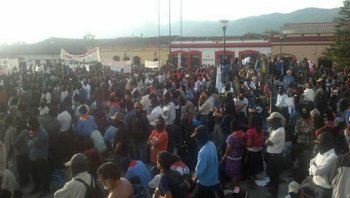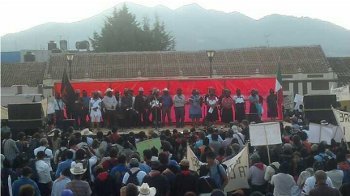Source: Narco News
Saturday’s Silent March in Chiapas Was Prelude to Sunday’s Convergence on Mexico City
By Natalie Long
Special to the Narco News Bulletin
May 8, 2011
On Saturday the Zapatistas, The Other Campaign, and members of the civil society of San Cristóbal de las Casas, Chiapas took to the streets, conducting a silent march that proceeded from the northwestern part of the city to the town center.
With participants numbering in the thousands, this march was held in solidarity with a larger, nationwide march that is currently taking place. The nationwide march started in Cuernavaca, Morelos this past Thursday, March 5, and will arrive Sunday in Mexico City.

DR 2011 Gerardo Ozuna |
The larger nation-wide march is largely due to the efforts of renowned Mexican poet Javier Sicilia. This past March 28, Sicilia’s son was found dead near Cuernavaca, Morelos, with the body showing signs of torture prior to his death. Roughly a week after his son’s death, Sicilia published a letter in the Mexican magazine Proceso on April 3, denouncing the system of violence in Mexico. In this letter, Sicilia stated that Mexicans were “hasta la madre” (“had it up to here”) with the violence and corruption present in their country, and he called for the mobilization of civil society to reclaim Mexico for its citizens. His most recent call for mobilization is that of the ongoing march, also known as the Caravan for Peace with Justice and Dignity.
Following Sicilia’s convoking of this march, the Zapatista Army of National Liberation (EZLN) released a communiqué on Thursday, April 28, announcing its intent to hold a silent march on Saturday, May 7, in San Cristóbal de las Casas, Chiapas. In a letter from Subcomandante Marcos released on the same day as the communiqué, he noted that financial constraints meant it would not be possible for the EZLN to travel to Cuernavaca or to Mexico City to participate in the larger nationwide march. Thus, in accordance with the modest means available to the EZLN, Subcomandante Marcos announced the EZLN’s intention to march in silence in San Cristóbal. The EZLN communiqué further indicated that this silent march would be to support and stand in solidarity with the national voice that seeks to reclaim justice for the people.
Thus, Saturday saw the gathering of the EZLN and its supporters in San Cristóbal de las Casas. By 10:00am, a large contingent of Zapatistas was lined up outside of CIDECI, the Indigenous Center for Integral Training, also known as the University of the Land. When arriving on the street that leads to CIDECI, one had to travel by foot to cover the 10-minute walk from the end of the street to the university, given that the street was filled with masked Zapatistas, prohibiting the passage of vehicles.
The Zapatistas came from all parts of the state of Chiapas. Various regions were represented, not only by the traditional outfits of the women, but by the symbols sewn onto the pasa montañas worn by members of the EZLN. On the front of the majority of the pasa montañas, a patch identified a person’s caracol by number and a person’s region by color. The different colors of the patches included red, yellow, orange, purple, blue, white, grey, and green, amongst others.

DR 2011 Gerardo Ozuna |
By 12:15pm, the Zapatistas began lining up outside of CIDECI, preparing to file out. The Zapatistas included the entire age spectrum, from children being carried by their mothers to senior citizens with gray hair poking out from beneath their masks. The women seemed to outnumber the men two to one. The Zapatistas also showed representation from both urban and rural areas. Rural female Zapatistas were easily identified by their traditional trajes, or, dresses that many wore. Some of the women were present at the march despite the absence of shoes on their feet. Many of the rural male Zapatistas bore the usual dress of the campesino, including rainboots, long-sleeve cotton shirts and cotton pants. Some of the men had traditional outfits as well, though not as many as the women. The urban Zapatista contingent provided a curious contrast, perhaps best exemplified by one young woman wearing large headphones over her pasa montaña. Other urban Zapatistas sported tighter shirts and jeans, items that are more familiar to those living in an urban setting with access to retail stores.
At approximately 1:10pm, a woman at the head of the march wearing a pasa montaña received an order through her radio, and ordered those at the beginning of the march to file out. It seemed that the march was underway, the masked EZLN members walking silently in their ranks bearing their signs with phrases such as “Estamos Hasta la Madre por la Guerra de Calderon!” (“We Have Had it Up to Here with Calderon’s War!”), “Alto a la Guerra de Calderon” (“Stop Calderon’s War”), and “No Mas Sangre” (“No More Blood”).
By 1:25pm, however, the march had stopped. The silence was broken by the chatter of radios as those at the head of the march worked to orient themselves inside of the colony from which the march was supposed to exit. As those with the radios consulted one another, people from nearby houses, stores, and workshops came out to look at the halted procession of masked Zapatistas. After roughly ten minutes of conversation, the march got underway once more, proceeding down a street in the direction of the highway to San Juan Chamula.
The column was met by yet another challenge, however, before it was to exit onto the highway. Around roughly 1:35pm, the head of the march met up with another group of Zapatistas – it seemed that the head of the march had met with the tail of the march. On the one hand, that was an impressive occurrence, showing that the Zapatistas had convoked so many people that the streets were not navigable. On the other hand, this caused general confusion, with the roads being blocked up. The head of the march could not proceed with their fellow members impeding their path, and thus had to patiently wait for the rest of their compañeros to file by. By 2:00pm, the conch shell was blown once more and the head of the march proceeded a ways further. This progress was stopped short once more as the head of the march ran into more Zapatistas coming in their direction.
With this new obstacle, roughly five or six authorities gathered around to confer. Radios in hand, they stood in the middle of a circle created by men joining hands, creating a protective space for the authorities to speak and make decisions. As the authorities spoke softly amongst themselves and into their radios, the ranks of Zapatistas watched and waited patiently for their orders.
Throughout the whole process, various actions served to remind the onlooker that indeed, the EZLN is an army, and should be regarded as such. Between the quick response to marching orders given by the authorities, the organized lines in which the Zapatistas proceeded, and the clear chain of command that was present, the bystander was obligated to remember that the procession passing by was that of a military organization, able to be summoned if necessary by the heads of the EZLN.
By 2:35pm, the Zapatistas had reached a consensus about how to proceed, and the march began orienting itself. First the EZLN authorities proceeded down the road, with other Zapatistas joining hands to form a protective circle around the authorities. Immediately behind the authorities came the head of the march, bearing their banner decrying Calderon’s War. The procession snaked its way through the jungle of cars and trucks parked on the sides of the road, the very vehicles that had delivered members of the EZLN to that part of town earlier on. Some Zapatistas remained on the side of the road, waiting for their moment to join the march. Many of those waiting had set up camp, pulling out their lunches as their compañeros marched by.
By 2:55pm, the march met the highway that leads to the center of town in one direction, while leading to the municipality of San Juan Chamula in the other direction. As the EZLN met the oncoming cars, the Zapatistas spilled out onto the street stopping traffic. Some cars simply came to a stop, while others began turning around. As the march proceeded through the streets, the sounds predominantly heard were a mixture of protesting car horns, the slapping of sandals and boots on the asphalt pavement, and the eerie sounding of a conch shell. The occasional comment was shared between marchers, but overall the Zapatistas remained silent as they proceeded down the highway to the center of town. As luck would have it, upon arriving at a streetlight, the EZLN had a green light and proceeded through the intersection unimpeded.
With the march in full force proceeding through the street toward the center of town, it was led first by a group of several men with radios, followed by the Mexican flag and the EZLN flag. One man and one woman bore the Mexican flag, as did a male-female team bearing the EZLN flag.
At 3:45pm, the head of the march arrived at the town center, greeted by a variety of onlookers, including waiters peering out from restaurants, tourists snapping photos, and locals standing by watching the march pass through the center. Patrons at nearby coffee shops put down their mugs to come watch the Zapatistas march by, some commenting quietly that the sight was impressive. By 3:50pm, the EZLN began filing into the plaza in front of the main cathedral in the city, heading for a stage on which several microphones were set up. The speech, however, was not yet ready to begin.
During the wait, many Zapatistas sat down to take a short break, pulling back masks to grab a quick drink of water or soda, some running to the nearby convenience store, masks still on, to pick up a snack. Conversations began quietly to circulate amongst those sitting together, some conversations in Spanish, others in various indigenous languages.
Although the initial movements of the march were perhaps a bit rough, upon arrival in the cathedral plaza, the EZLN showed impressive organization, coordinating which delegations were to be placed in certain locations in preparation for the speech. Around 4:45pm, the march continued to arrive in the plaza. A representative of the EZLN came to the microphone, asking the Zapatistas already in the plaza to move forward, since there were compañeros backed up for nearly 20 minutes who had not yet arrived.
By 5:05pm, the members of The Other Campaign finally arrived at the plaza. Delegations arrived from a whole host of communities, perhaps the most visible being Cruztón, Mitzitón, the Ejido Tila, Huixtan, and Bachajón. Other members of civil society were represented as well, including members of the Centro de Derechos Humanos Fray Bartolemé de Las Casas (Center of Human Rights FrayBa), the Centro de Derechos de las Mujeres (Center of Rights for Women), and the Brigada Feminista por la Autonomia (Feminist Brigade for Autonomy). Although an important sign of solidarity, the Zapatista presence by far dominated the entire event.
For the women of the collectives from the communities of Aguacatengango, La Grandeza, Napite, Corostik, Coquiteel, Sulupwitz, Frontera Comalapa, Santa Rosa de Coban, Yaluma, Chihuahua, and Bella Vista del Norte, they provided their word and their reason for marching. Recognizing the sorrow they feel and the tears they shed when they hear news of violence, the women also noted the courage they feel in defending themselves against the rapes and murders perpetrated by those whom the government allows to go free. The women spoke out against violence, not only in the form of weapons, but in the inherent violence present in sentencing a population to poverty, saying the government “not only murders us with weapons, with its guns, it also murders us with poverty, with the hunger in our village that they use to cheat us with. . . .” The women then called for justice, an end to violence, for respect, and liberty for the Mother Earth, amongst other demands to society and to the government.
The FrayBa also provided its word to the public regarding the march. Protesting President Felipe Calderon’s politics of war that has claimed the lives of nearly 40,000 victims, the FrayBa noted that impunity was the key to continuing this climate of violence. The FrayBa signaled the march as sign of the hope for life and for the demand of justice as civil society strives to achieve a dignified life for all.
Amongst those Zapatista sympathizers participating in the march, one in particular commented that the nation-wide march was a necessary event that the country had been awaiting. The EZLN march was a promise given by the Zapatistas that they had fulfilled, making good on their word to those participating in the larger movement.
After over an hour since the head of the march arrived in the plaza, at 5:10pm the EZLN authorities took to the stage. Calling the assembly to a salute, the crowd first sang the Mexican national anthem, followed by the EZLN anthem. Hardly surprising, the EZLN anthem resounded a bit more forcefully than the national anthem. Upon completing both anthems, a representative stepped up to the microphone to provide those gathered with the word of the EZLN.
The representative who spoke condemned the violence present in Mexico, stating that the history of Mexico has resulted in the spilling of innocent blood, and that peace and justice are nowhere to be found in the country. The speaker decried the fact that “the only guilt of these victims is to have been born or to live in a country that is misgoverned by legal and illegal groups thirsty for war, death, and destruction.” He denounced the converting of schools and universities into zones of war, and the overall state of fear for one’s life that is present in the simple act of traveling to work. Further, the speaker criticized the government, whom he stated as having provided false declarations and promises to the mothers and fathers who demanded justice on behalf of their murdered children. Yesterday, declared the speaker, was when the people of Mexico heard the dignified words of the victims and their families. Today is the day of their dignified silence, a silence that states, just as loudly as their words, that they want peace, justice, and a dignified life. The struggle of these victims and their families was not born of personal interest, but was rather “born of the pain of losing someone whom you love as much as you love life.” Reaching the end of the speech, the orator declared that today, the people who convoked the nation-wide movement are calling for those gathered to fight for life, and that the people gathered in the city today were there to respond to that call.
Wrapping up the speech, the representative and the crowd raised their fists and shouted seven times, sending a message of solidarity to the victims and their families, saying, “No estan solos!” (” You are not alone!”).
At 5:45pm, the Spanish presentation concluded and was followed by cheers, applause, and approving whistles. The same speech was then presented in various indigenous languages, including Tzotzil and Tzeltal. Around 7:00pm, nearly three hours after the head of the march arrived in the center of town, the EZLN authorities descended from the stage, bringing the assembly to a close. With the close of the ceremony, the silence was officially broken, as chatter arose amongst the Zapatistas as they filed out according to their groups. Despite having taken the better part of the day to assemble the members of the EZLN and its supporters in the plaza, within thirty minutes there was not a mask to be seen in the center of town. The cleanup crews went to work, and the members of the communities set out for home, taking word of their experiences back with them.






